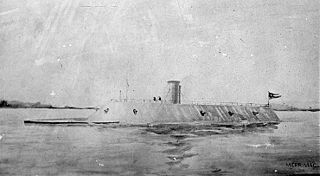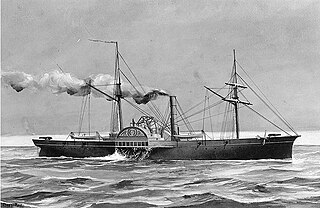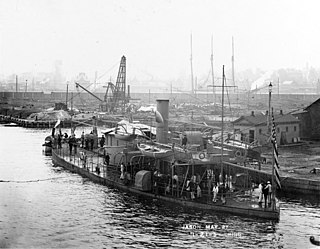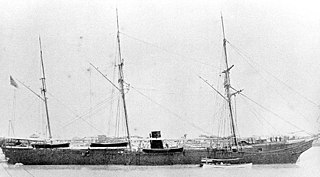
CSS Virginia was the first steam-powered ironclad warship built by the Confederate States Navy during the first year of the American Civil War; she was constructed as a casemate ironclad using the raised and cut down original lower hull and engines of the scuttled steam frigate USS Merrimack. Virginia was one of the participants in the Battle of Hampton Roads, opposing the Union's USS Monitor in March 1862. The battle is chiefly significant in naval history as the first battle between ironclads.
CSS Scorpion was a Squib-class torpedo boat that served in the Confederate States Navy during the American Civil War. Armed with a single spar torpedo, she originally served guard duty on the James River after being built in late 1864. Along with the rest of the James River Squadron, Scorpion moved downriver on January 23, 1865, and participated in the Battle of Trent's Reach. After performing depth soundings near Union obstructions, Scorpion moved to get a lantern from the ironclad CSS Virginia II, but ran into a hawser and then ran aground. At 07:10 on the morning of January 24, Union fire struck the abandoned tender CSS Drewry, which then exploded. The force of the explosion swept Scorpion out of control downriver. An attempt to rescue her that night failed, and she was captured by Union forces.

CSS Patrick Henry was a ship built in New York City in 1859 by the renowned William H. Webb for the Old Dominion Steam Ship Line as the civilian steamer Yorktown, a brigantine-rigged side-wheel steamer. She carried passengers and freight between Richmond, Virginia and New York City. Yorktown was anchored in the James River when Virginia seceded from the Union on 17 April 1861 and was seized by the Virginia Navy and later turned over to the Confederate Navy on 8 June 1861. Commander John Randolph Tucker, who commanded the ship, directed that Yorktown be converted into a gunboat and renamed Patrick Henry in honor of that revolutionary patriot. She also served as the first flagship of the James River Squadron.

The Battle of Hampton Roads, also referred to as the Battle of the Monitor and Merrimack or the Battle of Ironclads, was a naval battle during the American Civil War.

CSS Virginia II was a Confederate Navy steam-powered ironclad ram laid down in 1862 at the William Graves' shipyard in Richmond, Virginia. Acting Constructor William A. Graves, CSN, was the superintendent in charge of her construction. In order to conserve scarce iron plating, he ordered the ship's armored casemate shortened from the specifications given in John L. Porter's original building plans; in addition, the ship's iron-plating, while six inches thick on the casemate's forward face, was reduced to five inches on her port, starboard, and aft faces. Due to the shortening of her casemate, the number of her cannon were reduced to a single 11" smoothbore, a single 8" rifle, and two 6.4" rifles.

CSS Richmond was the name ship of her class of six casemate ironclads built for the Confederate States Navy during the American Civil War. The ship was built at Gosport (Norfolk) Navy Yard to a design by the Chief Naval Constructor, John L. Porter, with money and scrap iron collected by the citizens of Virginia, whose imagination had been captured by the ironclad CSS Virginia. Consequently, she was sometimes referred to as Virginia II, Virginia No. 2 or Young Virginia in the South and as Merrimack No. 2, New Merrimack or Young Merrimack by Union writers, months before the actual CSS Virginia II was ever laid down.

USS Merrimack, also improperly Merrimac, was a steam frigate, best known as the hull upon which the ironclad warship CSS Virginia was constructed during the American Civil War. The CSS Virginia then took part in the Battle of Hampton Roads in the first engagement between ironclad warships.

CSS Raleigh was originally a small, iron-hulled, propeller-driven towing steamer operating on the Albemarle and Chesapeake Canal. She was taken over by the State of North Carolina in May 1861, and transferred to the Confederate States the following July. Her commanding officer during 1861–1862 was Lieutenant Joseph W. Alexander. Her entire service was in coastal waters of North Carolina and Virginia and in the James River as part of the James River Squadron.
The CSS Beaufort was an iron-hull gunboat that served in North Carolina and Virginia during the Civil War.

CSSHampton was a wooden gunboat of the Confederate States Navy, one of the few Hampton class gunboats to be built.

CSS Fredericksburg was a casemate ironclad that served as part of the James River Squadron of the Confederate States Navy during the American Civil War. Laid down in 1862 and Launched the following year, she did not see action until 1864 due to delays in receiving her armor and guns. After passing through the obstructions at Drewry's Bluff in May 1864, she participated in several minor actions on the James River and fought in the Battle of Chaffin's Farm from September 29 to October 1. On January 23 and 24, 1865, she was part of the Confederate fleet at the Battle of Trent's Reach, and was one of only two Confederate ships to make it past the obstructions at Trent's Reach. After the Confederate attack failed, Fredericksburg withdrew with the rest of the James River Squadron. On April 3, as the Confederates were abandoning Richmond, Fredericksburg and the other vessels of the James River Squadron were burned. Her wreck was located in the 1980s, buried under sediment.

CSS Teaser had been the aging Georgetown, D.C. tugboat York River until the beginning of the American Civil War, when she was taken into the Confederate States Navy and took part in the famous Battle of Hampton Roads. Later, she was captured by the United States Navy and became the first USS Teaser.

William Augustin Webb was an American sailor and Mexican–American War veteran who resigned his United States Navy commission after more than 20 years of service to join the Confederate States Navy in the American Civil War. Webb was decorated for his service as Captain of the CSS Teaser, part of the James River Squadron, during the Battle of Hampton Roads (1862).

USS Sangamon was a Passaic-class ironclad monitor constructed for the Union Navy during the second year of the American Civil War where she operated in the waterways of the Confederate States of America. She was later recommissioned and placed into service during the Spanish–American War.

Joseph Nicholson Barney was a career United States Navy officer (1835–1861) who served in the Confederate States Navy in the American Civil War (1861–1865).
The James River Squadron was formed shortly after the secession of Virginia during the American Civil War. The squadron was part of the Virginia Navy before being transferred to the Confederate States Navy. The squadron is most notable for its role in patrolling the James River, which was the main water approach to the Confederate capital, Richmond. It had two phases: early war, when it consisted mostly of wooden ships which ended with the Battle of Drewry's Bluff on May 15, 1862; and its later ironclad composition with the flagship CSS Virginia II.

USS Wachusett (1861) – the first U.S. Navy ship to be so named – was a large (1,032-ton), Mohican-class steam sloop-of-war that served the United States Navy during the American Civil War. She was outfitted as a gunboat and used by the Navy as part of the Union blockade of the Confederate States of America.

USS Young America (1855) was a Confederate steamer captured by the Union Navy’s blockade vessels, and subsequently placed in-service in the Union Navy during the American Civil War.
USS Alpha (1864) was a side wheel paddle steamer acquired by the Union Navy during the American Civil War.

The Squib class torpedo boats were built for the Confederate States Navy during the later stages of the American Civil War. After the torpedo boat CSS David attacked and damaged the ironclad USS New Ironsides, the Confederates continued building torpedo boats with hopes of breaking the Union blockade. Four vessels of the class – CSS Hornet, CSS Wasp, CSS Squib, and CSS Scorpion – were constructed in Richmond, Virginia, in 1864. All were armed with a single spar torpedo and were powered by steam engines. Squib damaged the gunboat USS Minnesota in an attack on April 9, 1864, and was later sent to Wilmington, North Carolina, where she was scuttled in February 1865. The other three vessels of the class were all part of the James River Squadron and participated in the Battle of Trent's Reach on the night of January 23 and 24, 1865. Scorpion ran aground during the battle, and was forced downriver and out of control after the tender CSS Drewry exploded on January 24. She was later captured by Union forces and may have been burned. Hornet was sunk in a collision with another vessel on January 27, and Wasp was scuttled on the night of April 2/3, as the Confederates were abandoning Richmond.

















